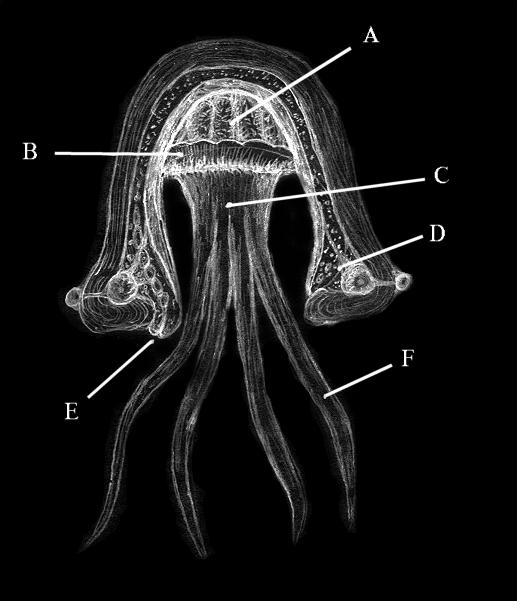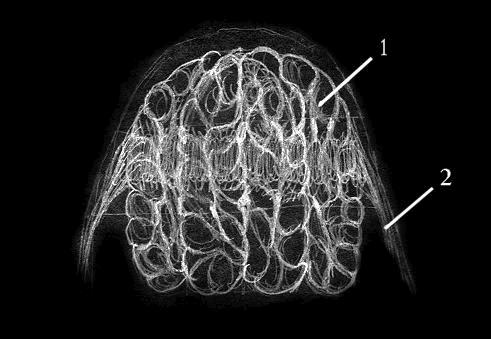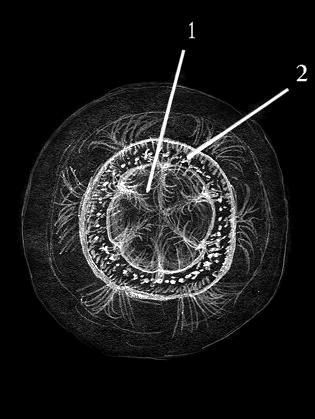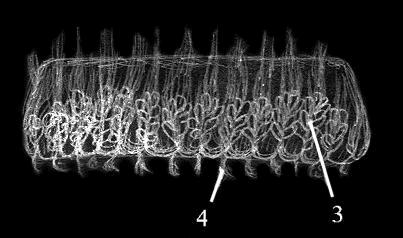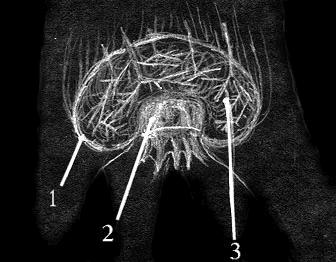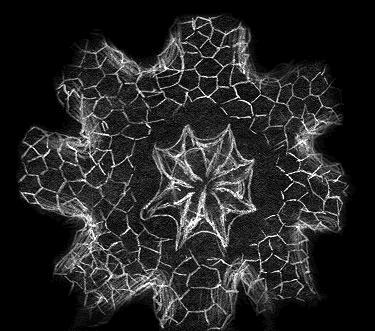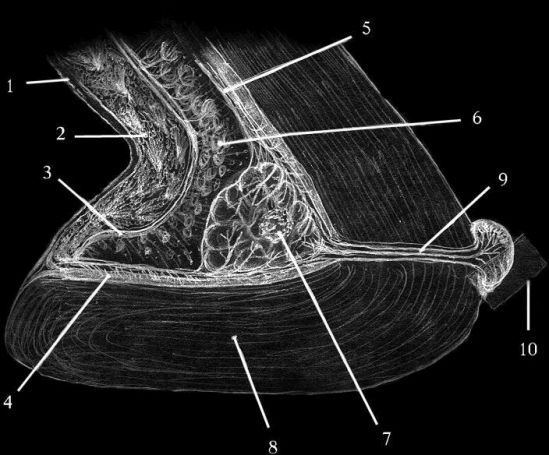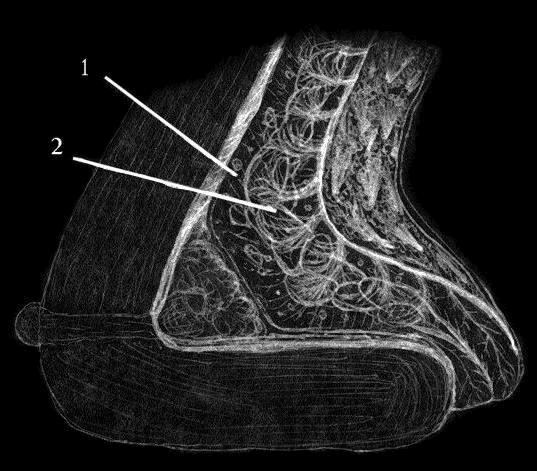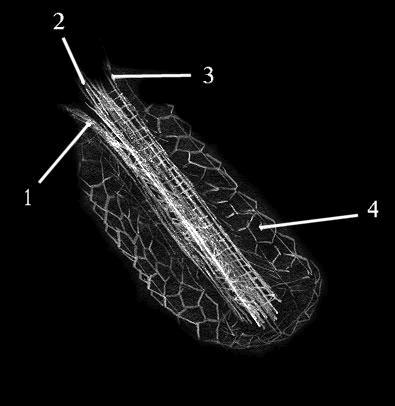Contents
Nervous, Circulatory and Immune Systems
A. The trunk brain(1) is essentially a homogeneous collection of folded nervous tissue; other than the eight lobes, no substructures are obvious upon visual inspection, though a number of regions are readily differentiated in brain activity scans. Particularly active are the connections among the lobes and the interface with the visual nerve net(2).
Nerves, like regulatory pathways and the other classes of Centauran vascular tissue, are bundles of long protein tubules with hollow cores. The channel in each species of tubule is capable of passing only one or two types of ion, and then no more than one at a time; these dedicated channels are extremely rapid and efficient at transporting substances. Centaurans' great tolerance to variations of temperature and pressure is partly explained by their lack of liquid-carrying vessels. This does, however, mean that they have no immune cells circulating; that function is carried on by a colony of microscopic symbiotes.
Pulmonary & Auditory Systems
B. The lung(2) extends in a ring around the brain(1) in the middle portion of the trunk; from this point up, the trunk is firmly anchored to the bell. Alveoli(3), thickly laced with pulmonary and venous circulatory tubules, perform gas exchange with the air wafted in by cilia(4). Sensory nerve endings near the cilia provide Centaurans with a very limited ability to sense sound, which is strongest in the lower frequencies.
Reproductive Systems
C. The uterus(1) (named so for its basic function, not for any tissue-level similarity to the mammalian organ) is located in the lower trunk between the tentacles. It becomes active at the age of twenty one standard years and remains so until about 250 years of age.
Approximately every six years (barring excessive environmental stresses) during the lowest point in the metabolic cycle, a small portion of the usually inactive pluripotent mass(3) begins rapidly expanding and differentiating. By the peak of the cycle, the young(2) has fully formed and a new layer of epidermis grown between it and the parent, at which point it is removed. The young quickly thereafter begins to lose the tentacle webbing and to replace the chitin shell with a silicate one.
Shell, Circulatory System & Photosynthesis
D. The translucent epidermis(1), which can range in color from blues and violets to pink, is a tough but flexible protein that covers tentacles and everything inside the bell but for the lung. Covering the other side of the organs is the cuticle(4). This organ, enriched with the dense endings of the subcuticular circulatory net(5) produces a new layer of shell(8) (composed of silicate with traces of violet pigments) during the growth period of each cycle.
The cardionephron(2) is packed with conical bundles of special circulatory tubule. By means of carefully regulated rates of diffusion, enormous ion gradients are created between the top and bottom of each nephron. The potential energy of these gradients is the driving force for all nerve and circulatory activity.
A highly vascularized layer between the cardionephron and the cuticle is the verdiferous tissue(6) (which is actually rather blue in color). This contains numerous interconnected capsules, ranging in size from microscopic to a few centimeters. The dendritic circulatory net(3) penetrates each capsule with hundreds to millions of tubule endings, providing a large surface area for the growth of the Centaurans' photosynthetic symbiotes. A certain portion of the verdiferous tissue also participates in digestive and storage functions.
In order to make use of an enormous visual field (360 degrees horizontally and nearly 180 vertically) generated by their forty-eight eyes (or fifty, in some familial lines) Centaurans require the use of a large organ to preprocess the information. The optic annulus consists of highly folded tissue surrounding a tight bundle of nerve(7) that runs the circumference of the bell. It functions as something like a second brain, processing visual information into spatial relationships. Abstract spatial thought, such as visualizing multi-dimensional data, takes place as a cooperation between the annulus and the trunk brain.
The optical nerve(9), along with a specific portion of the subcuticular circulatory net (the ocular circulatory net), passes through a channel in the cuticle and shell to branch out within the support tissue of the eye. The nerve endings connect to the back of the hemispherical retina in a simple one-to-one relationship with the retinal sensors. The circulatory net goes on to exit around the edge of the eye, covering the outer surface(10). Not only does it provide nutrients, but changes in the ion concentrations it carries also affect its transparency and the amount of light reaching the retina. While the retina by itself is a deep violet, the circulatory net gives the eyes an iridescent pinkish tinge. Minor abrasions to the nets of a few eyes make little difference to vision. Serious chips or cracks require an entire growth period or more to recover; if significant portions of the retinal support tissue are destroyed, the eye may never regenerate fully.
Digestion & Fiber Spinning
E. As previously mentioned, the verdiferous tissue(1)does more than support the nutritional symbiotes. A string of large capsules, together with an opening in the epidermis, constitute the oral cavity(2) It is used during the low period of the growth cycle every few weeks to consume, digest, and store nutrients which cannot be provided by the symbiotes. Silicates and other minerals are extracted by the production of a hydrogen fluoride solution which quickly dissolves most substances (and turns organic materials not protected by alkaline conditions into carbon and water).
Some of this mineral solution is used for growth, healing and reproduction, while other components are concentrated in the spinneret. This gland, located just inside the opening to the oral cavity, can extrude fiberous silicate crystals. Any material that is indigestible or in excess is expelled from the oral cavity when the growth begins. The Centauran practice of consuming the dead does have some biological underpinnings in that shell material is much more efficiently digested than an equally-sized piece of quartz.
Muscles, Touch and Taste
F. The interior of the tentacles consists primarily of muscle tissue(2) - pairs of contractile filaments existing as long strings of bare protein bundled together. The endings of nerves(3) directly from the lower portion of the trunk brain and circulatory tubules(1) from the middle of the cardionephron are interwoven with the filaments.
The epidermis(4) on the tips of the tentacles thins enough to allow nerve endings to reach the surface, making possible highly developed tactile and chemical senses.
